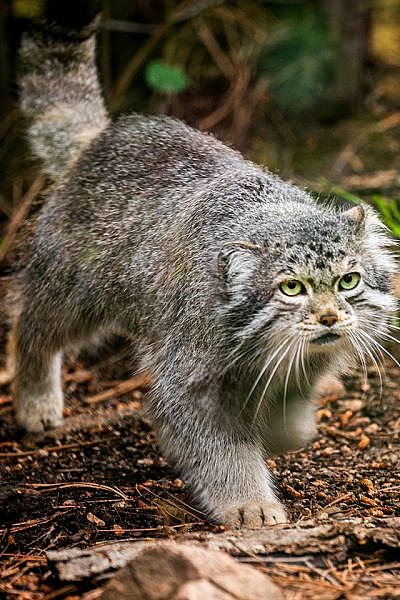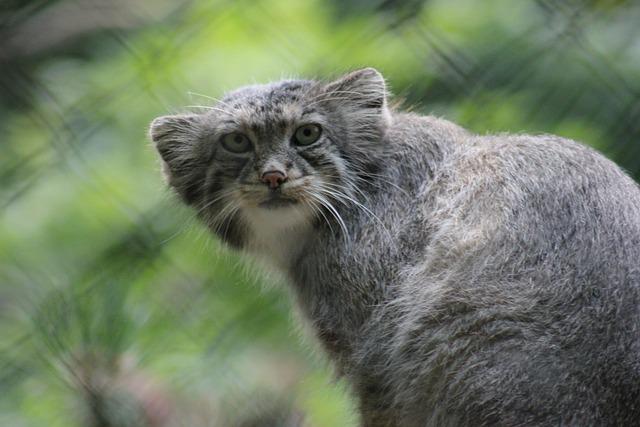The Pallas cat, sometimes referred to as Rock Wildcat, Manul, or Steppe cat are small and furry cats that are found in the Asian steppes.
Manuls have stocky bodies that are covered in adorable soft fur. They also have a rich cover of woolly and dark underfur.
Their coat color can vary from a yellowish buff and russet to a light grey. They also have some tips of white that give it a frosted appearance.
Pallas cats have round necks, owl-like yellow eyes, short ears, and black spots that are scattered over the head.
Their tails are covered in thick fur like the rest of their body and they have short and stout legs.
This cat is indeed a beauty to behold and it makes sense why so many people are wondering if they can keep one as a pet.
In this post, we will delve deeper into this subject, so keep reading to find out.
Can A Pallas Cat Be Domesticated?

The simple answer is no, Pallas cats cannot be domesticated. These cats are wild and have immunity that is adapted for high altitudes. Additionally, they are an endangered species.
Let us look at each of these reasons in greater detail below:
1. They Are Wild Animals
Don’t let the cute looks fool you – the Pallas is a wild animal and it may inflict harm on your family members or other pets.
In addition to the danger they pose, they are also accustomed to living in the wild, so domesticating them would probably make them miserable.
However much you try, you cannot provide an environment that would offer them as much stimulation as they get in the wild.
2. Unlearned Immune System
Pallas cats are adapted to living in high altitudes – they typically make their dens in rocky crevices that are as high as 15,000 feet. This is one reason why spotting these cats in the wild is not that easy.
Because they are accustomed to living at such altitudes, their immunity is adapted for such heights.
If you bring these cats to your home, their immunity will be ill-equipped in dealing with the virus, bacteria, fungi, and other pathogens that live at low altitudes.
As such, they will be exposed to all manner of ailments that will affect their quality of life or even result in death.
3. Endangered Species
Pallas cats are endangered. According to the School of Marine and Environmental Affairs at Washington University, there are less than 15,000 Pallas cats remaining in the wild.
The IUCN has also placed this cat on its red list of endangered species.
These cats have traditionally been targeted by hunters because of their exceptional fur.
Thankfully, protective laws have been enforced that have reduced this hunting. But in some regions (like Mongolia), hunting Pallas for domestic needs is still a legal practice.
Another reason why their numbers have been dwindling is that humans have been killing their primary food source (pika and vole) which are considered pests.
Climate change and habit degradation due to human activity are some other reasons why this cat is endangered.
Can Pallas Cat Breed With The Domestic Cat?

It is widely believed that the Sand cat and the Pallas cat may have contributed to the genes of the domestic cat breeds that have long hair.
In fact, some experts believe that it is not a coincidence for the Persian cat to have been found near the Pallas cats.
Peter Pallas (the German naturalist that discovered Pallas cats) reckoned that a Pallas could breed with a domestic cat although there is no evidence that this has ever been tried.
Related Post: Can A Bobcat Mate With A Domestic Cat?
Reproduction and Lifespan
Researchers have recorded that Pallas cats can live for up to 12 years in captivity.
The exact lifespan in the wild is unknown but it would be safe to infer that it is longer than 12 years.
These cats have a very high mortality rate. A whopping 68% of the kittens do not survive into adulthood while the adult mortality rate is also at 50% mostly because of natural predators like red foxes and eagles.
Their highly seasonal mating doesn’t help either. These cats typically mate from December to March and the kittens will then be born from March to May.
They have a gestation of 66-75 days and the litter size is usually anything from 1-6 although 3-4 is the more common number.
Parting Thoughts
Pallas cats are no doubt adorable –their round heads, short ears, and round face will make anyone turn their heads.
But as adorable as they may be, these cats should not be domesticated.
Pallas cats are adapted for high altitudes and this means their immunities may not be equipped to deal with the pathogens we have in low altitudes.
Additionally, these cats are endangered and should therefore be left to be in the wild and only government agencies and conservationists should own them to preserve the species from extinction.
Related Posts:

Hi! I am Eleanor Price. I started this website after my cat, Louie, almost died from a case of botulism (a type of food poisoning often caused by bacteria that grow on food items). Turned out that my cat’s diet was the problem. I have made it my duty to provide the best information and recommendations about everything cat lovers need to know about their felines’ health and wellbeing. My goal is to find the most informative content on anything feline-related and share it with fellow hardworking kitty lovers.

